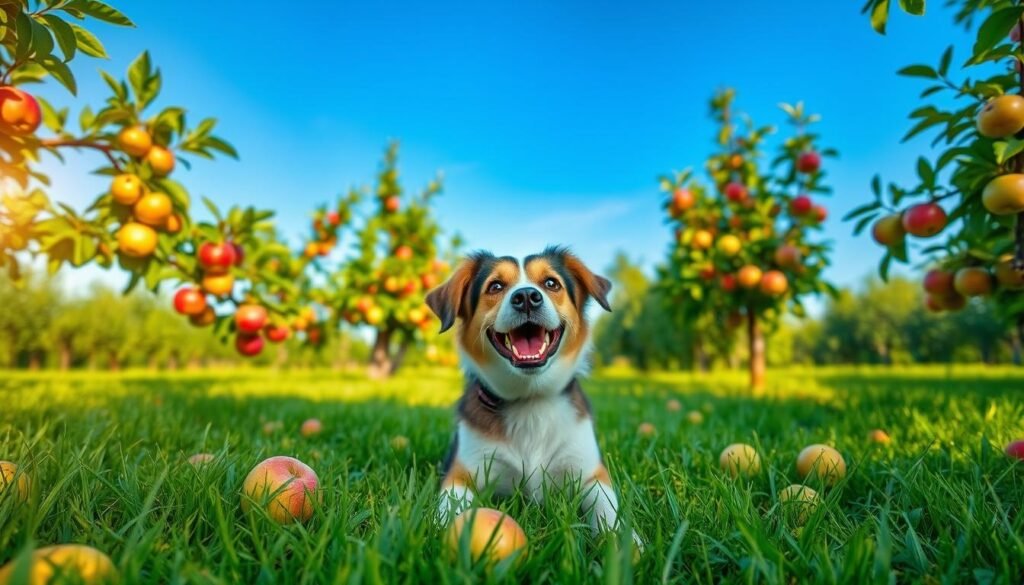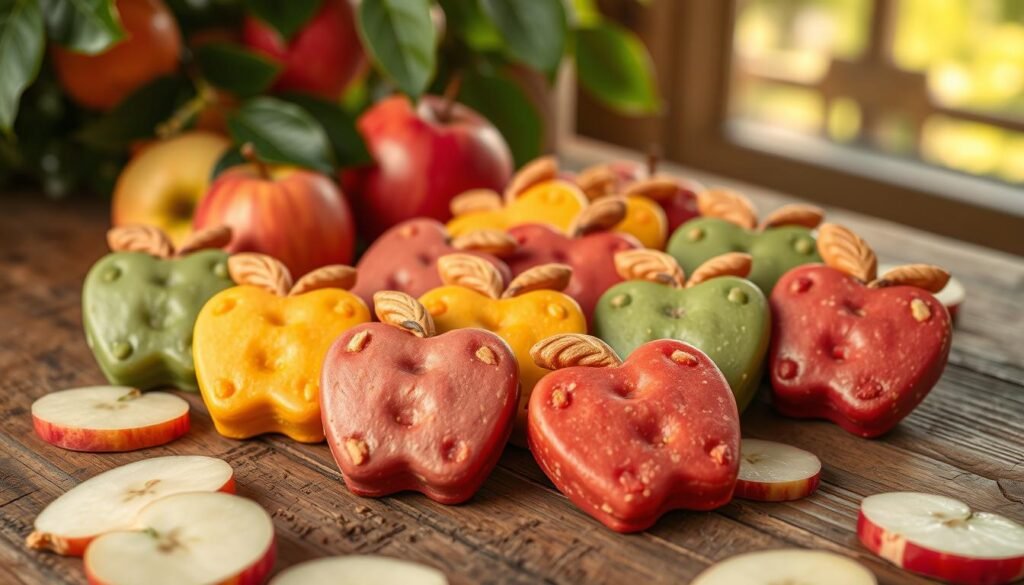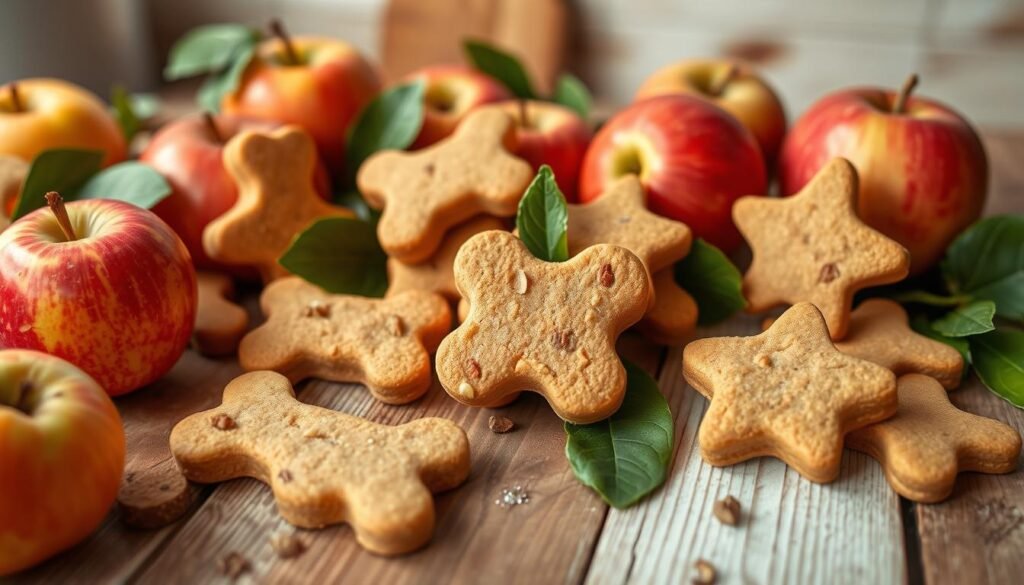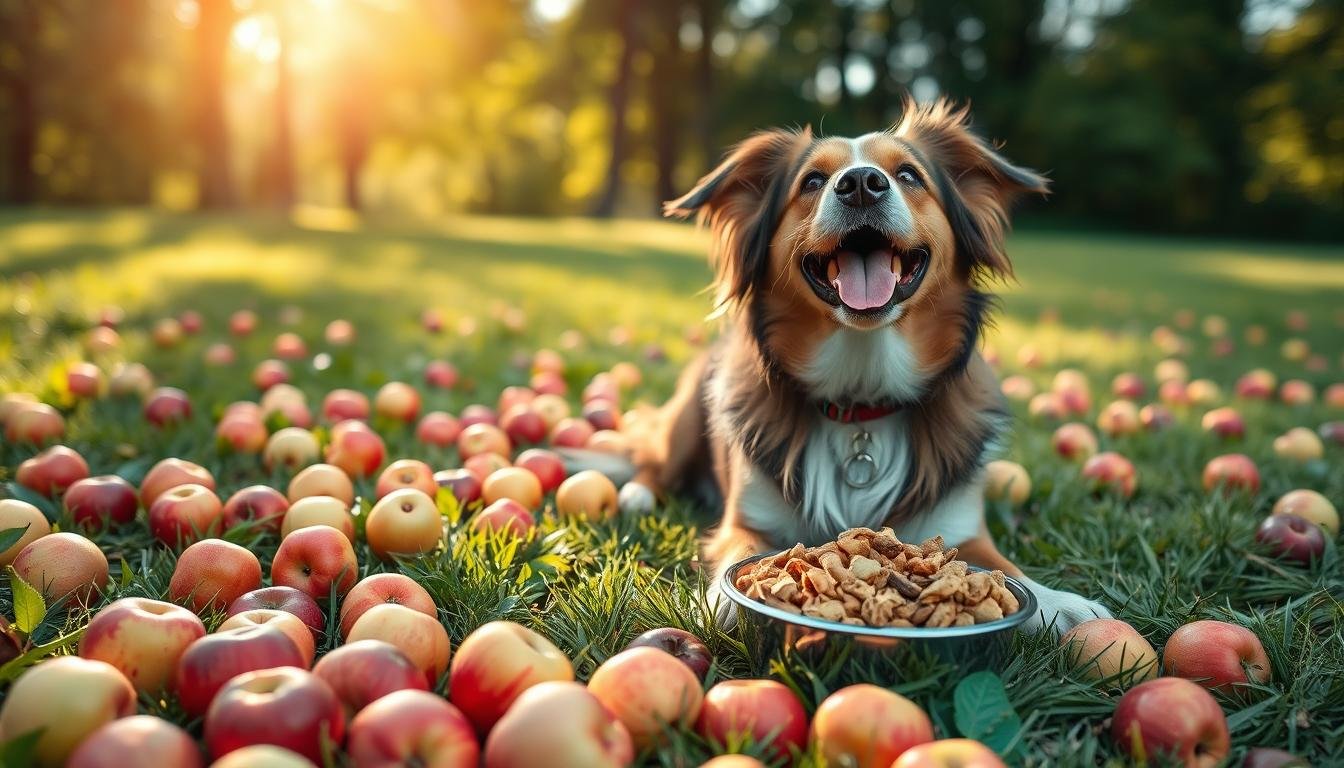As a dog owner, I love sharing food with my furry friend. But, I must make sure it’s safe for them. That’s why I’m looking into dog nutrition and apple safety for canine health1. Cesar Millan says some foods can harm dogs, so knowing what’s safe is key.
About 60% of dog owners use fruits and veggies as treats, with apples being a favorite1. This shows how important it is to know about apple safety for dogs. Apples are full of antioxidants, which can help keep pets healthy and long-lived1. They’re a great choice for dog owners who want to give their pets healthy snacks.
Key Takeaways
- Apples can be a healthy treat for dogs when given in moderation1.
- Approximately 60% of dog owners use fruits and vegetables as treat substitutes for their pets1.
- Apples are high in antioxidants, which can enhance overall pet health and longevity1.
- Dog owners should prioritize dog nutrition and apple safety to ensure their pets’ canine health1.
- Understanding the benefits and risks of feeding apples to dogs is crucial for their overall health and well-being1.
Can Dogs Eat Apples? The Quick Answer
As a dog owner, knowing what human foods are safe is key. Apples are safe for dogs, but with some care2. They’re full of fiber, vitamins, and antioxidants, making them a great snack.
But, it’s important to take out the seeds and core. They have cyanide, which is bad for dogs2. Apples are packed with nutrients, making them a healthy choice for dogs. Just remember to give them in small amounts to avoid stomach problems.
Here are some benefits of apples for dogs:
- Rich in fiber, which can help support healthy digestion
- Good source of vitamins and antioxidants, which can help boost the immune system
- Low in calories, making them a great treat for dogs on a canine diet
Always talk to your vet before changing your dog’s dog food or adding new foods like apples3.
| Food | Safe for Dogs | Precautions |
|---|---|---|
| Apples | Yes | Remove seeds and core |
| Pears | Yes | Remove seeds and core |
Understanding the Benefits of Apples for Dogs
As a dog owner, it’s key to think about what treats we give our pets. Apples are full of good stuff like vitamins, minerals, fiber, and antioxidants. These help keep our dogs healthy and happy.
Apples have vitamins A and C, potassium, and fiber. These help with digestion, boost the immune system, and can help with weight management4. They’ve even been shown to help fight cancer in dogs.
Apples are also low in calories, making them a great choice for treats. They can be a fresh snack, added to meals, or used as rewards. Their fiber and antioxidants support healthy digestion and overall health, making them a nutritious treat for dogs4.
| Nutrient | Benefit |
|---|---|
| Vitamin A | Supports healthy vision and immune function |
| Vitamin C | Boosts immune system and supports collagen production |
| Potassium | Helps regulate fluid balance and supports healthy muscle function |
| Fiber | Supports healthy digestion and can help manage weight |
Apples are a tasty and healthy treat for dogs. They offer many benefits for their health and nutrition4.
Potential Risks and Dangers
As a dog owner, knowing the risks of feeding apples to dogs is key. While apples can be good, dog safety comes first. Foods like chocolate, grapes, and onions are toxic to dogs and can harm their health5.
Apples have seeds and cores with amygdalin, a toxic compound. It releases cyanide when eaten5. This shows how important it is to keep our dogs safe. Some fruits, like apples, are good for dogs, but seeds must be removed5.
To avoid apple risks, we must know the dangers and take steps to protect our dogs. This means removing seeds and cores from apples. By understanding these risks and acting on them, we can keep our dogs safe and healthy5.
Which Parts of the Apple Are Safe?
When it comes to dog nutrition, knowing what foods are safe is key. Apples can be a healthy treat for dogs, but only certain parts are safe. According to6, dogs can eat apples without seeds and core because the seeds have cyanide, which is harmful.
The apple’s flesh is full of fiber and vitamin A7. It’s a great treat for dogs. But, it’s important to remove the seeds and core to keep dogs safe. Apples can be a good part of a dog’s diet, but only in small amounts to avoid stomach problems7.
Here are some key considerations for apple safety in dog nutrition:
- Remove seeds and core before giving apples to dogs6
- Choose apples that are fresh and free of pesticides7
- Feed apples in moderation to prevent digestive issues7
In conclusion, knowing about apple safety is crucial for a dog’s diet. By following these guidelines, owners can ensure their dogs stay healthy and happy6.
| Food | Safety for Dogs |
|---|---|
| Apples (without seeds and core) | Safe6 |
| Apple Seeds | Not Safe6 |
| Apple Core | Not Safe6 |
How to Prepare Apples for Your Dog
Preparing apples for your dog is important for their safety and fun. According to8, you should wash, core, and slice apples before giving them to dogs. This step helps avoid choking and digestive problems. Apples can be a nutritious treat for dogs, supporting their health.
To get started, wash the apples well to remove dirt and harmful stuff. Next, take out the seeds and hard center. Then, cut the apples into thin pieces that are easy for your dog to chew. You can also make healthy treats like frozen apple carrot ones, which are quick to make9. These treats are tasty and good for your dog’s health.
Here are some tips for preparing apples for your dog:
- Always wash the apples before giving them to your dog
- Remove any seeds or tough center pieces to prevent choking hazards
- Slice the apples into thin, bite-sized pieces for easy digestion
- Consider making healthy dog treats, such as frozen apple carrot treats, to support your dog’s canine nutrition
By following these steps and tips, you can make sure your dog enjoys apples safely. Whether you give them as treats or mix them into meals, proper preparation is key. It helps support their health and nutrition8.
| Apple Preparation Step | Importance |
|---|---|
| Washing | Removes dirt, bacteria, and pesticides |
| Coring | Prevents choking hazards and reduces digestive issues |
| Slicing | Ensures easy digestion and chewing |
Best Apple Varieties for Dogs
Choosing the right apple varieties for dogs is key for their health and nutrition. Apples are a great snack for dogs, but some are better than others. Sweet apples are safer for dogs than tart ones, as they cause fewer digestive problems10. Organic apples are also a better choice, as they are free from harmful pesticides7.
Some top apple varieties for dogs include Gala, Fuji, and Honeycrisp. These apples are sweet and juicy, perfect for dogs. But, always remove the seeds and core, as they can be toxic10. Look for apples that are rich in fiber and vitamins to boost your dog’s health11.
Here are some tips for choosing the best apple varieties for your dog:
- Opt for sweet apples over tart apples
- Choose organic apples over conventional apples
- Remove seeds and core before serving
- Consider apple varieties that are high in fiber and vitamins

By following these tips and picking the right apple varieties, you can give your dog a healthy snack. This snack will support their overall health and nutrition7.
Signs Your Dog May Not Tolerate Apples
As a dog owner, watching your dog’s health is key, even with new foods like apples. Apples can be good for dogs, but some may not do well. They might show signs like diarrhea, stomach issues, or skin problems12.
Feeding apples to dogs can have risks. Apple seeds have amygdalin, which can release cyanide. Too many apples can also cause stomach problems13. If you see these signs, talk to your vet about your dog’s diet.
Some dogs might react to apples, showing signs like ear infections or skin issues12. To avoid this, start with small amounts of apples and watch your dog closely. This way, you can keep your dog healthy and balanced13.
Every dog is unique, so what works for one might not for another. If you’re unsure about apples or see any signs of trouble, ask your vet for advice13.
Creative Ways to Serve Apples to Your Dog
As a dog owner, I’m always on the lookout for new ways to add apple recipes to my dog’s meals. Apples are packed with fiber, vitamins A and C, and antioxidants that are good for dogs14. They can also be used to make tasty and healthy dog treats. Making homemade apple chips with safe ingredients is one of my favorite things to do15.
Here are some creative ways to serve apples to your dog:
- As a fresh snack: Slice up an apple and serve it as a crunchy and healthy snack for your dog.
- Added to dog food: Mix diced apples into your dog’s regular meals for an extra boost of fiber and nutrients.
- Used in homemade dog treats: Apples can be used to make a variety of healthy dog treats, such as apple chips, apple biscuits, and even apple and peanut butter sandwiches14.

When serving apples to your dog, it’s important to control the portion sizes. This is because apples have natural sugar that can upset a dog’s stomach14. By getting creative with apples, we can make sure our dogs get the benefits of this nutritious fruit. With a little imagination and some basic ingredients, you can make healthy and tasty dog treats that your furry friend will love.
How Much Apple Can Dogs Eat?
Understanding the right amount of apples for dogs is key in dog nutrition. The size of the apple serving depends on the dog’s weight and needs16. Small dogs should get 1-2 small apple slices, while medium dogs can have up to 6 slices16. Large and extra-large dogs can enjoy a handful of small apple pieces16.
Apples are a good, low-calorie treat for dogs. But, eating too much can upset their stomach because of sugar and fiber16. It’s important for dog owners to know the risks and take steps like washing apples well to avoid pesticides and bacteria16.
| Dog Weight | Apple Serving Size |
|---|---|
| Small | 1-2 small apple slices |
| Medium | Up to 6 small apple slices |
| Large/Extra-Large | A handful of small apple pieces |
Dogs should not eat fruits and veggies for more than 10% of their daily calories12. By following these guidelines, we can make sure our dogs enjoy apples safely and healthily.
Storing and Preserving Apple Treats
As a dog owner, it’s key to store apple treats right. This keeps them fresh and full of nutrients. Apples can stay fresh in the fridge or freezer17. This is crucial for dogs, as apples are a healthy snack.
When storing apple treats, remember a few things. First, keep them in an airtight container. This stops moisture and contaminants. Second, apples can last up to a week in the fridge or three months in the freezer18. This makes them perfect for dog treats, as they’re easy to store and keep.
Here are some tips for storing and preserving apple treats:
- Store apples in an airtight container to maintain their freshness
- Keep apples in the fridge for up to a week or freeze for up to three months
- Use apples as a healthy and nutritious snack for dogs, as part of a balanced canine nutrition plan
By following these tips, your dog’s apple treats will stay fresh and healthy. This makes them a great choice for their diet. With the right storage, apple treats can be a tasty and nutritious snack for dogs, supporting their health19.

Always put your dog’s health first by giving them healthy snacks like apple treats. Proper storage and preservation help support your dog’s nutrition. This keeps them happy and healthy.
| Storage Method | Shelf Life |
|---|---|
| Fridge | Up to 1 week |
| Freezer | Up to 3 months |
Other Fruits That Are Safe for Dogs
As a dog owner, it’s key to think about canine nutrition when adding new fruits. Apples are great, but bananas, blueberries, and strawberries are safe too20. These fruits offer vitamins, minerals, and antioxidants that boost dog health.
It’s important to know which fruits are safe and which are not. Grapes and raisins can harm dogs, even in small amounts7. But bananas and blueberries are safe and good for your dog’s health, aiding digestion and the immune system.
Here are some safe fruits for your dog’s diet:
- Bananas: rich in potassium and fiber, but should be given in moderation due to their high sugar content20
- Blueberries: rich in antioxidants, vitamins, and fiber, making them a low-calorie, nutritious option for dogs7
- Strawberries: beneficial for dogs, but should be fed in moderation to avoid upset stomachs7
Always introduce new fruits slowly and in small amounts. This helps prevent any bad reactions. So, your dog can enjoy a variety of healthy treats while staying healthy20.
| Fruit | Safe for Dogs | Health Benefits |
|---|---|---|
| Apples | Yes | Rich in vitamins A and C, fiber, and antioxidants |
| Bananas | Yes | Rich in potassium, fiber, and vitamins |
| Grapes | No | Can cause kidney failure in dogs |
Conclusion
Apples can be a great addition to a dog’s diet. They offer important vitamins, minerals, and fiber that help keep them healthy7. By following the right steps, we can add this tasty fruit to our dogs’ meals safely and effectively. It’s key to avoid the core and seeds because they can be harmful7.
Also, remember to give apples in moderation. Too much can upset their stomachs21.
As pet owners, knowing which foods are safe is crucial. Foods like grapes, raisins, onions, and garlic are toxic to dogs21. By knowing the risks and benefits, we can make better choices for our pets. I hope this article helps you safely add apples and other fruits to your dog’s diet. This will help keep them healthy and happy.

